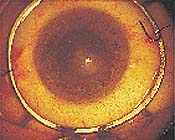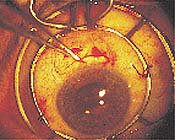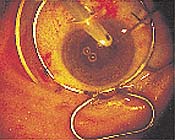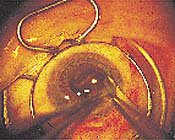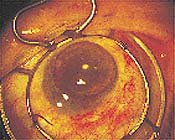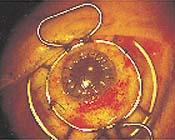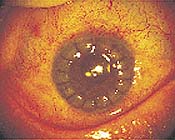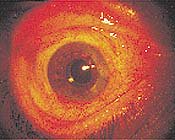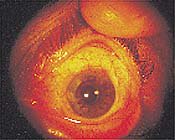Following electrocution, patient develops a corneal leukoma and cataract
Both were treated successfully with combined surgery of perforating keratoplasty, cataract removal and IOL implantation.
Eye injuries subsequent to high-tension electricity usually occur when the electric contact takes place in the cephalic region. They are, however, rare.
Cataracts caused by the passage of electricity from one side of the body to the other (right hand to left hand or feet) have been even less frequently reported.
However, in most cases, the electric shock causes a loss of consciousness, making it very difficult to establish, particularly after a period of time has elapsed.
In addition to cataracts (generally posterior subcapsular), the most frequently described ocular injuries following electrocution include uveitis, retinal folds, optic neuropathies and cystoid macular edema, which can develop into a macular hole.
This article reports an extremely rare case of a patient that developed a corneal leukoma and a cataract as a consequence of electrocution, both of which were treated successfully by surgery.
Case report
A 62-year-old male patient, without former ophthalmologic history, had been examined by an ophthalmologist some months before the accident. In both eyes, the cornea appeared specular and transparent with a natural vision of 20/20.
In an accident at work, the patient underwent high voltage electrocution. He lost consciousness and was admitted to intensive care where he remained in a coma for 20 days.
Upon awakening, he complained of a visual deficit in the right eye. When examined, corneal leukoma and a prevalent nuclear cataract were diagnosed. No pathologies were found in the left eye.
Several months after the accident, the patient came under our observation. Upon examination with the slit lamp, the right eye showed diffuse, but not very dense, corneal opacity at the level of the epithelium, stroma and endothelium. The leukoma was slightly vascularized. Some opacity of the nucleus and posterior pole of the lens was observed. Corrected vision was about 20/400. The fundus, explored with difficulty, appeared healthy. Intraocular pressure was 16 mm Hg.
We performed combined perforating keratoplasty with cataract removal and IOL implantation on the right eye. We removed the cataract masses with phacoemulsification and then implanted an IOL into the posterior chamber. After corneal drilling with a disposable 7-mm drill, we removed the leukomatous corneal flap. The grafted corneal flap was then stitched with 16 separate 10-0 nylonsutures.
The patient was followed-up at 15, 30, 60 and 120 days. At the present time, 4 years after surgery, the flap is perfectly transparent, IOP is good and the corrected visual acuity is 20/25.
Discussion
After a careful review of the literature, we decided to describe this case for the extreme rarity of the association between corneal leukoma and cataract following electrocution.
Interestingly, the patient had an ophthalmological examination only 2 months prior to the accident. This emphasizes the direct relationship between the electrocution and the ocular pathology.
A normal postoperative course led to good functional recovery.
|
| |
|
|
|
|
|
|
|
|
|
|
|
|
For Your Information:Reference:
- Alfredo Sammartino, MD, can be reached at Ocular Microsurgery, Villa Esther, 86021 Bojano, Italy; (39) 08-652-6676; fax: (39) 08-7441-1416.
- Boozalis GT, Purdue GF, Hunt JL, McCulley JP. Ocular changes from electrical burn injuries. J Burn Care Rehabil. 1991;12:458-462.
- Perron-Buscail A, Lesueur L, Chollet P, Arne JL. Les brulures electriques corneennes. J Fr Ophthalmol. 1995;18(5):384-386.
- Biro Z, Paner Z. Electrical cataract and optic neuropathy. Int Ophthalmol. 1994;18(1):43-47.
- Handa JT, Jaffe GJ. Lightning maculopathy. A case report. Retina. 1994;14(2):169-172.
- Augustin AJ, Koch F, Boker T. Macular damage following lightning strikes. Ger J Ophthalmol. 1995;4(4):214-216.
- Espaillat A, Janigian R Jr., To K. Cataracts, bilateral macular holes and rhegmatogenous retinal detachment induced by lightning. Am J Ophthalmol. 1999;127(2):216-217.

